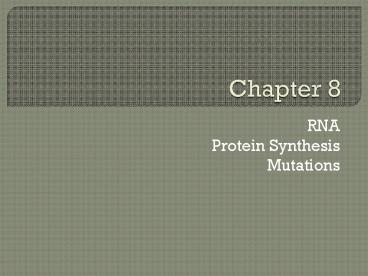RNA - PowerPoint PPT Presentation
1 / 37
Title:
RNA
Description:
RNA Protein Synthesis Mutations * Substitution Insertion Deletion Chromosomal mutations involve changes in the number or structure of chromosomes. – PowerPoint PPT presentation
Number of Views:132
Avg rating:3.0/5.0
Title: RNA
1
Chapter 8
- RNA
- Protein Synthesis
- Mutations
2
RNA Structure Function
3
Structure of RNA
- RNA differs from DNA in three ways
- an RNA molecule consists of a single-strand of
nucleotides - RNA has ribose (5-C sugar) rather than
deoxyribose - RNA has the pyrimidine uracil instead of thymine
4
Types of RNA
Function
mRNA transmits information from DNA and serves as a template for protein synthesis
tRNA brings amino acids to ribosomes for protein synthesis
rRNA rRNA and proteins make up ribosomes
5
3 Types of RNA
6
Protein Synthesis
- Has 2 stages
- Transcription and Translation
7
Protein Synthesis Part 1 Transcription
- Transcription is the first part of protein
synthesis. - What does it mean to transcribe?
- Step 1 An enzyme called RNA polymerase attaches
to DNA and unzips it. - Step 2 RNA polymerase then uses one strand of
DNA as a template from which nucleotides are
assembled into a strand of mRNA.
8
Adenine (DNA and RNA) Cystosine (DNA and
RNA) Guanine(DNA and RNA) Thymine (DNA
only) Uracil (RNA only)
RNApolymerase
DNA
RNA
9
Protein Synthesis Part I Transcription
- The nucleotide sequence of DNA is converted into
an RNA nucleotide sequence. - Lets say one strand of a DNA molecule had this
sequence - AGCCTACGTAAG
- What would the mRNA sequence produced be?
10
Protein Synthesis Part 1 Transcription
- DNA AGCCTACGTAAG
mRNA UCGGAUGCAUUC
11
(No Transcript)
12
Review of Proteins
- Proteins are made by joining amino acids together
into a long chain. This chain is a protein. - The functions and properties of a protein are
determined by the order in which 20 different
types of amino acids are joined. - The language of mRNA is called the genetic
code.
13
The Genetic Code
- RNA has 4 bases adenine, uracil, cytosine, and
guanine. - The language of RNA is written in only 4
letters AUGC - The code is read three letters at a time
- Each word is 3 letters long
- Each word of 3 nucleotides is called a codon
14
The Genetic Code
- The 4 different bases can be arranged into 64
possible codons (4X4X464), but make only 20
different amino acids. - This is because some amino acids correspond to
several different codons. - Example
15
Genetic Code
- Practice
- For what amino acid does the codon CGG code?
- For what amino acid does the codon AUG code?
- For what amino acid does the codon UGA code?
16
(No Transcript)
17
Codons With Special Roles
Start Codon
Stop Codons
18
Protein Synthesis Part 2 Translation
- The 2nd stage of protein synthesis is
translation. - What does it mean to translate?
- The sequence of nucleotides in mRNA serves as
instructions for the order in which amino acids
should be joined together in a protein. Think of
mRNA as the recipe for a protein.
19
Protein Synthesis Part 2 Translation
- Transcription occurs in the nucleus.
- In translation, the mRNA travels out of the
nucleus, and moves through the cytoplasm and
attaches to a ribosome. So, translation occurs
at the ribosomes.
20
Protein Synthesis Part 2 Translation
- Steps of translation
- 1. mRNA attaches to a ribosome
- 2. As each codon of the mRNA molecule moves
through the ribosome, the proper amino acid is
brought to the ribosome by tRNA molecules. - 3. Each tRNA molecule has 3 unpaired bases on
it. These bases are called anticodons.
21
Protein SynthesisPart 2 Translation
- 4. The amino acids are strung together like a
chain (remember, a protein is a polymer) by the
ribosome, forming a long protein molecule. - 5. The tRNAs are released from the amino acids.
- 6. The protein chain grows longer and longer
until the ribosome reaches a stop codon on the
mRNA molecule. Then the protein is released from
the ribosome.
22
(No Transcript)
23
(No Transcript)
24
(No Transcript)
25
(No Transcript)
26
(No Transcript)
27
(No Transcript)
28
Practice
DNA
mRNA
tRNA
Poly- peptide
29
Mutations
- Gene Mutation produce changes in a single gene
- Chromosomal Mutations produce changes in an
entire chromosome
30
Gene Mutations
- A gene mutation is a change in a DNA sequence.
- Gene mutations that involve changes in only one
or just a few nucleotides are called point
mutations b/c they occur at a single point in the
DNA sequence. - There are 3 types of point mutations
substitutions, deletions, and insertions.
31
Gene Mutations
- Substitution Mutations
- One base is changed to another
- Usually affect no more than a single amino acid,
but could still have an effect on a protein.
32
Gene Mutations
- Insertion Mutations
- One extra base is inserted into the DNA sequence.
- Deletion Mutations
- One base is left out of the DNA sequence.
33
Genetic Mutations
- Since the genetic code is read 3 letters at a
time, the message is shifted for every codon that
follows. Hence, insertions result in frameshift
mutations. They have a dramatic effect on the
amino acid sequence, and thus, the protein. - Questionduring what event do these mutations
usually occur?
34
Gene Mutations
35
(No Transcript)
36
Chromosomal Mutations
- Chromosomal mutations involve changes in the
number or structure of chromosomes. - We discussed many of these last chapter.
Examples are Down syndrome, Turner syndrome,
Fragile-X syndrome, Prader-Willi syndrome, and
Klinefelters syndrome.
37
Chromosomal Mutations































